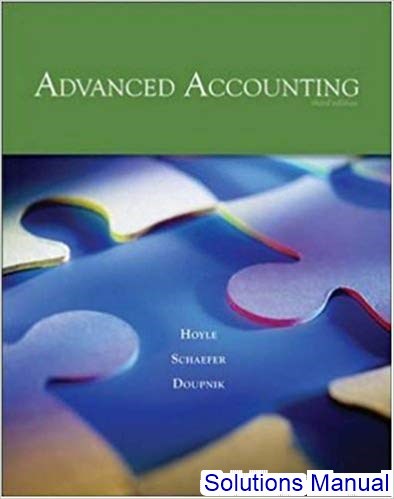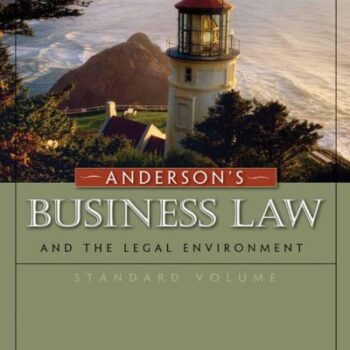
Solution Manual Advanced Accounting 9th edition by Hoyle
Original price was: $55.00.$28.00Current price is: $28.00.
Digital item No Waiting Time Instant DownloadISBN-13: 978-0073379456 ISBN-10: 007337945X
Hoyle Advance Accounting 9th Edition Solution Manual Accountancy was probably the first profession that began utilizing writing which goes to show its rich history. This manual contains solutions to all the textbook’s problems step by step and helps to understand difficult concepts like consolidations, partnership accounting, and foreign currency accounts. Thus, this book can provide tools that enable students to successfully confront advanced accounting techniques and their respective applications which are critical to the mastering of this topic.
Key Areas Covered in This Solution Manual
Equity Method Accounting The first manual describes equity method accounting procedures which of course are used when one company decides to invest in another. It includes areas like income from investments in terms of dividends as well as inter-company activities that affect financial statements. For students, this method serves as a guide explaining in detail how to account for ownership interests when one company owns a part of another company.
Concept of Consolidation and Goodwill
There are a lot of aspects that are broadly discussed in advanced accounting, and one of these areas includes consolidation and goodwill. Goodwill is understood in the context of the acquisition of one firm by another, the amalgamation of the accounting (financial) statements of two or more firms into one set of financials, and also the adjustment of purchase consideration that exceeds the net asset value of the firm. Therefore, there is such a definition of goodwill, which can be termed as the value of the company over the net identifiable assets of the company.
Foreign Currency Transactions and Translation
The manual also has guidelines on currency exchanges as well as transactions that aid the students in the course of their training, which is necessary, as students would engage with global business operations. This section is important for students who want to understand the effect of international operations on the consolidated financial statements of an international firm.
Partnership Accounting
The formation, operations, and liquidation of the partnerships are covered whilst exploring together with the accounting of the partnership’s equity. This area includes capital accounts of partners, allocation of net income, and divorcing economic ties of partner owners. For those who wish to engage in activities related to the accountancy of partnerships or any other involved with auditing small or private companies, it is extremely crucial to understand how partnership accounting is structured.
Intercompany Transactions
This section deals with the nature of upstream and downstream transactions and the need to hold back unrealized gains until such time as they are realized through transactions with outside parties. This aspect of consolidated financial statements assists in verifying the integrity of reported earnings.
Deferred Taxes
The manual contains instructions on how to deal with tax assets and liabilities that are deferred – crucial in tax administration and ensuring the tax a company has to pay is efficient enough not to interfere with its cash flow.
Benefits of Using the Solution Manual
- Enhances Understanding of Difficult Subjects: This manual allows the student to grasp those complex concepts and assignments by providing solutions in comprehensive detailed procedures in a step-by-step approach, in which each student is expected to manage each of the sections.
- Preparing for the Exams and Real Life: Questions addressing similar issues as those experienced in exams can enhance student preparedness and increase their confidence. Additionally, the manual offers realistic approaches to application in the field of accounting and finance.
- Improves Problem-Solving Ability: The students are expected to work out solutions, this will develop their focus on critical thinking that will help them resolve challenging accounting problems on their own.
Who Can Benefit from This Manual?
The Advanced Accounting Solution Manual written by Hoyle is appropriate for students, teachers, and practitioners of accounting who want to advance their skills on advanced accounting concepts. It is helpful for students during exam time, for an accounting practitioner who needs a recap, and for teachers who want to explain complicated concepts in a neat and organized way.
Summary
Advanced accounting techniques can be convenient and hassle-free for learners and professionals who have the Solution Manual for Advanced Accounting, 9th Edition by Hoyle. This manual assists the users in correct comprehension and application of various accounting principles and practices by addressing key topic areas like equity method accounting, consolidation, and goodwill, foreign currency transactions, partnership accounting, etc. This solution manual is a great asset for those who want to grow in the accounting profession as it offers a clear and detailed approach to accounting problem-solving.
Solution Manual Advanced Accounting 9th edition by Hoyle
CHAPTER 1 THE EQUITY METHOD OF ACCOUNTING FOR INVESTMENTS
Chapter Outline
- Three methods are principally used to account for an investment in equity securities.
-
- Fair-value method: applied by an investor when only a small percentage of a company’s voting stock is held.
-
-
- Income is recognized when dividends are declared.
-
-
-
- Portfolios are reported at market value. If market values are unavailable, investment is reported at cost.
-
-
- Consolidation: when one firm controls another (e.g. when a parent has a majority interest in the voting stock of a subsidiary or controls through variable interests (FIN 46R), their financial statements are consolidated and reported for the combined entity.
-
- Equity method: applied when the investor can exercise significant influence over the operating and financial policies of the investee.
-
-
- The ability to significantly influence investees is indicated by several factors including representation on the board of directors, participation in policy-making, etc.
-
-
-
- According to a guideline established by the Accounting Principles Board, the equity method is presumed to be applicable if 20 to 50 percent of the outstanding voting stock of the investee is held by the investor. SFAS 159, The Fair Value Option for Financial Assets and Financial Liabilities (effective 2008) allows firms to elect to use fair value
-
- Accounting for an investment: the equity method
-
- The investment account is adjusted by the investor to reflect all changes in the equity of the investee company.
-
- Income is accrued by the investor as soon as it is earned by the investee.
-
- Dividends declared by the investee create a reduction in the carrying amount of the Investment account.
- Special accounting procedures used in the application of the equity method
-
- Reporting a change to the equity method when the ability to significantly influence an investee is achieved through a series of acquisitions.
-
-
- Initial purchase(s) will be accounted for by means of the fair-value method (or at cost) until the ability to significantly influence is attained.
-
-
-
- At the point in time that the equity method becomes applicable, a retroactive adjustment is made by the investor to convert all previously reported figures to the equity method based on a percentage of shares owned in those periods.
-
-
-
- This restatement establishes comparability between the financial statements of all years.
-
|
McGraw-Hill/Irwin |
© The McGraw-Hill Companies, Inc., 2009 |
||||||||||||
|
Hoyle, Schaefer, Doupnik, Advanced Accounting, 9/e |
1-1 |
||||||||||||
- Investee income from other than continuing operations
-
- Income items such as extraordinary gains and losses and prior period adjustments that are reported separately by the investee should be shown in the same manner by the investor.
-
- The materiality of this income element (as it affects the investor) continues to be a criterion for this separate disclosure.
- Investee losses
-
- Losses reported by the investee create corresponding losses for the investor.
-
- A permanent decline in the market value of an investee’s stock should also be recognized immediately by the investor.
-
- Investee losses can reduce the carrying value of the investment account to a zero balance. At that point, the equity method ceases to be applicable and the fair-value method is subsequently used.
- Reporting the sale of an equity investment
-
- The equity method is consistently applied until the date of disposal to establish the proper book value.
-
- Following the sale, the equity method continues to be appropriate if enough shares are still held to maintain the investor’s ability to significantly influence the investee.
If that ability has been lost, the fair-value method is subsequently used.
IV. Excess cost of investment over book value acquired
-
- The price paid by an investor for equity securities can vary significantly from the underlying book value of the investee company primarily because the historical cost-based accounting model does not keep track of changes in a firm’s market value.
B. Payments made more than underlying book value can sometimes be identified with specific investee accounts such as inventory or equipment.
-
-
- An extra acquisition price can also be assigned to anticipated benefits that are expected to be derived from the investment. For accounting purposes, these amounts are presumed to reflect an intangible asset referred to as goodwill. Goodwill is calculated as any excess payment that is not attributable to specific accounts. For the year 2002 and beyond, goodwill is no longer amortized.
-
V.Deferral of unrealized gains in inventory
A. Gains derived from intercompany transactions are not considered completely earned until the transferred goods are either consumed or resold to unrelated parties.
B. Downstream sales of inventory
-
-
-
- “Downstream” refers to transfers made by the investor to the investee.
-
-
-
-
-
- Intercompany gains from sales are initially deferred under the equity method and then recognized as income at the time of the inventory’s eventual disposal.
-
-
-
-
-
- The amount of gain to be deferred is the investor’s ownership percentage multiplied by the markup on the merchandise remaining at the end of the year.
-
-
C. Upstream sales of inventory
-
-
-
- “Upstream” refers to transfers made by the investee to the investor.
-
-
|
McGraw-Hill/Irwin |
© The McGraw-Hill Companies, Inc., 2009 |
|||||||||||
|
1-2 |
Solutions Manual |
|||||||||||
- Under the equity method, the deferral process for unrealized gains is identical for upstream and downstream transfers. The procedures are separately identified in Chapter One because the handling does vary within the consolidation process.
Learning Objectives
Having completed Chapter One, “The Equity Method of Accounting for Investments,” students should be able to fulfill each of the following learning objectives:
- Identify the sole criterion for applying the equity method of accounting.
- Understand the purpose of the 20 to 50 percent guideline as it is to be used by an investor.
- Prepare the basic equity method journal entries for an investor.
- Discuss the theoretical problems associated with an investor’s accrual of equity income where no asset has yet been received from the investment and may not be received in the foreseeable future.
- Understand the appropriate means of recording a change from the market-value method to the equity method and the rationale for this handling.
- Identify the proper reporting to be used in applying the equity method when an investee is disclosing items such as extraordinary gains and losses or prior period adjustments.
- Know that any permanent decline in the fair market value of an investee’s stock must be immediately reflected in the financial records of the investor.
- Record the sale of an equity investment and identify the accounting method to be applied to any remaining shares that are subsequently held.
- Allocate the price paid to purchase an investment so that a determination can be made of amounts attributed to specific investee accounts and/or goodwill.
- Compute the annual amortization to be recognized on any excess payments made by the investor and prepare the journal entry to record this expense.
- Understand the rationale for deferring unrealized gains on intercompany transfers until the period in which the goods are either consumed or sold to outside parties.
- Compute the amount of an intercompany gain that is considered to be unrealized and make the journal entries to first defer the gain and then recognize it in the appropriate period.
- Identify the difference between upstream and downstream transfers.






